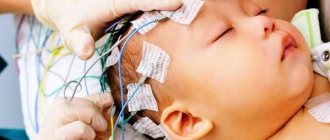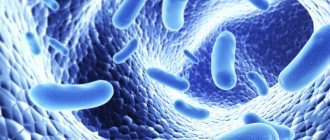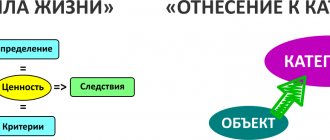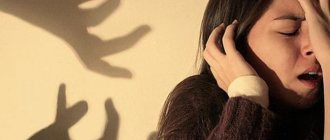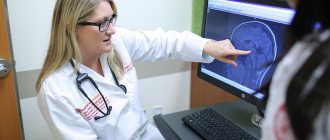Actions after an epileptic attack
An attack of epilepsy can be considered completed when a person’s muscles return to normal and are completely relaxed.
Sometimes the state of relaxation is accompanied by involuntary emptying of the bladder. The patient will not show any reactions for several minutes, but his condition will improve significantly. After the seizure ends, the following must be done: Place the person in a comfortable position on one side, if this was not done during the seizure. It is necessary to prevent the root of the tongue from sinking. Ask strangers, if any, to leave
Those who are able to provide some help, relatives, can stay with the person. Observe whether there are small body twitches. Support the patient if he tries to get up so that he does not fall. If you are in a place that is dangerous for the patient, where he may be injured when walking, you should leave him in the same place and do not move him until the ambulance arrives. The patient must decide for himself whether he needs medical care. It takes about 10-15 minutes until the condition is completely normalized, during which it is important to stay close to the person. You should not give a person medicine. If this is not the first attack in his life, he himself probably knows what to do next, what medications to take
When something like this happens for the first time, a diagnostic examination of the body is required to determine what means to treat it. Drinks containing caffeine are not recommended for the patient. In addition to them, you should not give a person spicy foods, salty or other substances that can provoke excitement of the nervous system. If a person really wants to sleep, you should not disturb him. It would be right to create the necessary conditions for this. Emergency care for an epileptic seizure consists of creating comfortable conditions for the patient.
After an attack of epilepsy, there are situations when the patient is unable to normalize the respiratory process. In this case, he needs to try to breathe as deeply as possible, drink water
It is important at such a moment to provide psychological support. The right thing to do is to talk to the person and try to calm him down if he is in shock.
It is better to lay the body on its side.
Treatment of epilepsy in a child
If a child has had at least two attacks, then he needs to take drugs such as valproate (Convulex), phenobarbital or carbamazepine, as well as Topomax and Keppra.
Taking these drugs is long-term; regularity is very important; if regularity is not observed, attacks may recur.
Most often, one drug is enough to prevent seizures. Antiepileptic drugs cause decreased attention, drowsiness, and lower school performance, but in no case should they be canceled or skipped, because withdrawal can immediately cause an attack. Each attack pushes the child’s development back.
The drug Convulex is used under the control of valproic acid in the blood. If valproic acid in the blood is more than 100 mcg/ml, then the dosage of the drug cannot be increased; if it is less than 50 mcg/ml, then the therapeutic dosage has not been achieved and the dose must be increased.
If a child has had at least one attack, then for a month he is strictly prohibited from any massage, drugs that stimulate the central nervous system, as well as classes with a speech therapist.
In case of symptomatic epilepsy, the tumor is removed, after which the attacks completely stop.
A new method has also appeared in the treatment of epilepsy - stimulation of the vagus nerve. To do this, the patient is implanted with a special electrical device. Stimulation of the vagus nerve improves the patient's emotional state.
What to do during an attack
Visually, an epileptic seizure, especially if you have not encountered it before, looks terrifying. As a rule, those around you at this moment become stupefied and do not understand what needs to be done. In fact, if an attack lasts several minutes, and basically it does, it does not pose any particular danger to a person if you protect him from the traumatic space and monitor him at this moment.
First aid for epilepsy is as follows:
sharp convulsive contractions begin instantly and at this moment the patient is no longer able to control himself
It is important to have time to pick him up and place him on a flat surface so that he does not injure himself when he falls; under your head, place a pillow, blanket or cushion from the clothes you have at hand; release the neck and chest area to facilitate breathing, if this has not been done previously; try to carefully turn the patient’s head to the side so that he does not choke on his own saliva and possible vomit, but under no circumstances hold his head down by force; do not give the patient anything to drink during an attack; you should not try to restrain the convulsions by force, they are uncontrollable and you can only cause injury to the patient; if the mouth is open, insert a piece of cloth or a handkerchief so that the patient does not damage his tongue. If your jaw is clenched, do not try to open it, you will not be able to do this without causing damage; the patient may stop breathing for a few seconds, you should be prepared for this
In this case, you don’t need to do anything, breathing returns on its own within a couple of seconds, just watch your pulse. In exceptional cases, breathing may cease for longer, then artificial respiration should be performed and an ambulance should be called; at the time of a seizure, involuntary urination or defecation may occur, which is normal for this disease.
Prevention of epileptic seizures
There are preventive recommendations that, if followed, can prevent epileptic seizures, especially if you already have a history of them:
- you should protect yourself from getting traumatic brain injuries;
- stop smoking, drinking alcohol and drugs;
- try not to stay in stuffy, unventilated rooms for a long time;
- avoid hypothermia;
- give preference to a healthy lifestyle and sports;
- avoid stressful situations;
- do not overwork;
- observe the work and rest schedule.
Epilepsy is a rather severe and difficult-to-treat pathology. Thanks to the prescription of modern anticonvulsants, doctors at the neurology clinic of the Yusupov Hospital are able to significantly improve the quality of life of their patients and prevent the development of new epileptic seizures in them.
An appointment with a neurologist at the Yusupov Hospital can be made by phone or on the clinic’s website. You can also ask questions regarding the conditions of hospitalization in a hospital and the estimated cost of the services provided.
Make an appointment
Author
Yuri Viktorovich Solomatin
Epileptologist, Ph.D.
First aid for epilepsy, what to do
Epilepsy is an incurable disease and is classified as chronic. Therefore, although there are many ways to help sick people, nevertheless, an attack can happen at any time.
In the past, an epileptic seizure led people into confusion and confusion, causing sacred fear. Now this disease has been well studied, because according to WHO, more than 40 million people suffer from it. Therefore, even if there are no relatives with epilepsy in your immediate environment, you still need to know the rules of first aid. After all, even a stranger may need it at any moment.
First aid for an epileptic attack, what you should and should not do during a seizure, video
Epilepsy is a chronic disease that manifests itself in the form of convulsive attacks and seizures.
associated with impaired perception of the external world (vision, smell, hearing), reactive (speech) and motor (uncontrolled, inconsistent gestures, numbness of the limbs or body) capabilities. Loss of consciousness is also possible (as a sudden attack or a consequence of several seizures in a fairly short period of time).
Epilepsy does not always begin immediately with frightening tonic-clonic seizures (screams, convulsive shudders, throwing back of the head, incomprehensible sounds). This form of epilepsy can develop gradually.
The first “bells” of the presence of the disease can be nightmares, night urination, screaming, and behavioral disturbances. Also, constant short-term stupors (gazing at one point, lack of reaction to others) can lead to a more complex form of epilepsy.
Despite the range of possibilities of modern medicine, it is not always possible to completely cure this disease or even identify its causes.
How to provide first aid to a person having an epileptic seizure
Almost always, epilepsy attacks occur in the most unexpected places and when there seems to be no reason for it. Let's consider the algorithm for providing first aid if you find yourself in the thick of things.
The algorithm for your actions if you witness an epileptic seizure is as follows:
First of all, call an ambulance. It is better, of course, if someone else does this, since it is not very convenient to help the patient and talk to the doctor at the same time.
But it is also possible that no one will be near you, or everyone will be very busy with their own important matters and therefore will not be able to stop and help, which happens all the time in our country.
In this case, quickly dial 03 or 112 on your mobile phone and put it on speakerphone. While the beeps are ringing, place the phone next to the victim, and in the meantime, begin to provide assistance.
When the other end of the line picks up, shout something like: “A citizen is having an epileptic attack, the city is such and such, the street is such and such, and, accordingly, the house is such and such.” This sequence of actions will save time, since while the ambulance is driving, you will be able to provide first aid.
- Next, you should bring the patient into a comfortable lying position, and you cannot move him to another place - this is strictly prohibited. Don't be afraid to get his clothes dirty - he will fall anyway, but if you help him, he will hurt himself less.
- It is necessary to make sure that his head looks not up, but to the side, and it is better if at the same time he himself lies on his side - then he will not suffocate with vomit or tongue. However, you should not hold it too tightly, otherwise it may get injured. Grab him by the fleshy parts and try to press him down lightly, but it is better if someone also holds him by the legs.
- Put some kind of rag in his mouth - a sweater sleeve, or a crumpled shirt - this will protect him from biting his tongue. But if your mouth is tightly closed, do not open it, as you may break the patient’s jaw.
- At first he will convulse, but after a couple of minutes he will calm down and lie disoriented for another half hour. During this time, the doctor will definitely arrive.
A child has an epileptic attack
Today it has been scientifically proven that epileptic seizures affect the body of an adult and a child differently.
And although in 99% of cases they have more serious consequences for the child, the first aid procedure in both cases is not fundamentally different.
However, it is important to take into account that a child’s fragile body is more easily damaged, injured, and so on, and one cannot ignore the fact that children, as a rule, are weak in spirit. Therefore, all the above actions must be carried out even softer and more carefully.
Is it possible to perform artificial respiration and chest compressions if they stop?
This is a rather controversial issue. The fact is that it is believed that such actions can only aggravate the situation, however, if the patient does not breathe for a long time (more than 1.5 minutes) and his heart does not beat, he will die in any case, and the above-mentioned resuscitation techniques will allow at least great negative consequences, bring him back to life.
What do seizures look like in epilepsy?
Seizures due to changes in certain parts of the brain
Local, partial or focal seizures are the result of pathological processes in one part of the human brain. Partial seizures can be of two types - simple and complex.
Simple partial seizures
With simple partial seizures, patients do not lose consciousness, but the symptoms present will always depend on which part of the brain is affected and what exactly it controls in the body.
Simple seizures last about 2 minutes. Their symptoms are usually expressed in:
- a sudden causeless change in a person’s emotions;
- the occurrence of twitching in various parts of the body - limbs, for example;
- feeling of deja vu;
- difficulty understanding speech or pronouncing words;
- sensory, visual, auditory hallucinations (flashing lights before the eyes, tingling in the limbs, etc.);
- unpleasant sensations - nausea, goose bumps, changes in heart rate.
Complex partial seizures
With complex partial seizures, similar to simple ones, the symptoms will depend on the area of the brain that is affected. Complex seizures affect a larger part of the brain than simple ones, causing changes in consciousness and sometimes loss of consciousness. The duration of a complex attack is 1-2 minutes.
Among the signs of complex partial seizures, doctors identify:
- the patient's gaze into emptiness;
- the presence of an aura or unusual sensations that occur immediately before a seizure;
- patient screams, repeating words, crying, laughing for no reason;
- senseless, frequently repeated behavior, automaticity in actions (walking in a circle, chewing movements without reference to food, etc.).
After the attack, the patient experiences disorientation. He does not remember the attack and does not understand what happened and when. A complex partial seizure can begin with a simple one, and then develop and sometimes turn into generalized convulsions.
Generalized seizures
Generalized seizures are a seizure that occurs when pathological changes occur in a patient in all parts of the brain. All generalized seizures are divided into 6 types - tonic, clonic, tonic-clonic, atonic, myoclonic and absence.
Tonic seizures
Tonic seizures got their name due to the special effect on human muscle tone. Such cramps provoke tension in muscle tissue. Most often this affects the muscles of the back and limbs. Typically, tonic spasms do not cause fainting. Such attacks occur during sleep and last no more than 20 seconds. However, if the patient is standing while they occur, he is more likely to fall.
Clonic seizures
Clonic seizures are quite rare compared to other types of generalized seizures, and they are characterized by rapid alternating relaxation and contraction of muscles. This process provokes rhythmic movement of the patient. Most often it occurs in the hands, neck, and face. It will not be possible to stop such a movement by holding the twitching part of the body.
Tonic-clonic seizures
Tonic-clonic seizures are known in medicine as grand mal - “big disease”. This is the most typical type of seizures that occur with epilepsy in the minds of many people. Their duration is usually 1-3 minutes. If a tonic-clonic attack lasts longer than 5 minutes, this should be a signal to urgently call an ambulance.
Tonic-clonic seizures have several phases. In the first, tonic phase, the patient loses consciousness and falls to the ground. This will be followed by a convulsive or clonic phase, since the attack will be accompanied by twitching, similar to the rhythm of clonic seizures. When tonic-clonic seizures occur, a number of actions or events may occur:
- the patient may experience increased salivation or foaming from the mouth;
- the patient may accidentally bite his tongue, which will lead to bleeding from the bite site;
- a person, without controlling himself during a period of convulsions, can get hurt or hit surrounding objects;
- patients may lose control over the excretory functions of the bladder and bowels;
- The patient may experience blue discoloration of the skin.
After the end of the tonic-clonic convulsion, the patient is weakened and does not remember what happened to him.
Atonic attacks
Atonic or astatic seizures, which involve brief loss of consciousness by the patient, get their name due to the loss of muscle tone and strength. Atonic attacks most often last up to 15 seconds.
When atonic seizures occur in patients in a sitting position, either falling or simply nodding the head may occur. If the body is tense in the event of a fall, it is worth talking about a tonic attack. At the end of the atonic seizure, the patient does not remember what happened. Patients prone to atonic attacks may be advised to wear a helmet, since such attacks contribute to head injury.
Myoclonic spasms
Myoclonic seizures are most often characterized by rapid jerking movements in some parts of the body, like small jumps inside the torso. Myoclonic seizures mainly affect the arms, legs, and upper body. Even those people who do not suffer from epilepsy may experience myoclonic spasms when falling asleep or waking up in the form of twitching or jerking. Hiccups are also classified as myoclonic spasms. Patients have myoclonic seizures affecting both sides of their body. The attacks last a few seconds and do not cause loss of consciousness.
The presence of myoclonic seizures may indicate several epileptic syndromes, for example, juvenile or progressive myoclonic epilepsy, Lennox-Gastaut syndrome.
The nature of absence seizures
Absence seizure or petit mal most often occurs in childhood and is a short-term loss of consciousness. The patient may stop, look into emptiness and not perceive the surrounding reality. In complex absence seizures, the child experiences some muscle movements, such as rapid blinking of the eyes, or chewing-like movements of the arms or jaw. Absences last up to 20 seconds in the presence of muscle cramps and up to 10 seconds in their absence.
With a short duration, absence seizures can occur repeatedly even within 1 day. They can be suspected if the child is sometimes able to switch off and does not respond to the treatment of people around him.
Epilepsy: first aid
Category: First aid
Epilepsy, as many probably know, is a disease expressed in paroxysmal disturbances of consciousness, as well as characteristic convulsions. The cause of seizures is the excessive bioelectrical activity inherent in neurons. Risk factors for people predisposed to epilepsy are those that cause neuronal damage.
Accordingly, epilepsy, for which first aid is extremely important for the patient, can occur due to brain injuries and infectious diseases (encephalitis, meningitis), as well as due to tumors and addictions to alcohol and drugs.
Epileptic seizures are almost always unexpected for the patient, and they often plunge people around them into a state of shock. Meanwhile, a generalized seizure is often felt by the patient several hours, or even days before its onset. Its symptoms manifest themselves in headaches and irritability, instability of moods, etc.
The convulsions themselves are often preceded by an aura that has strictly individual pleasant or unpleasant characteristics (joy and delight or headache and nausea). Almost immediately the person loses consciousness, followed by a possible scream. At first there is a tonic convulsion (about 30 seconds), followed by clonic convulsions (short, with twitching of the face and alternate flexion/extension of the limbs). The face becomes pale and livid, foam comes out of the mouth, and the pupils dilate. Patients often bite their tongue and may experience involuntary urination. The pressure rises sharply, after which muscle relaxation occurs, transitioning to sleep of varying degrees of duration. As for the duration of the seizure, it can be on the order of several minutes, or it can last up to half an hour; mainly during this period the patient experiences memory loss.
Epilepsy, during which first aid is provided before the arrival of doctors, requires the following actions:
To avoid injury, the patient should be placed on a flat, soft surface or objects that soften the blows (for example, clothing) should be placed under parts of the body that are beating in a seizure. The waist and neck should be freed from objects that tighten them and complicate breathing
Accordingly, the influence exerted by a belt, collar, tie and other objects is eliminated. If possible, the patient should be positioned in such a way that the possibility of inhaling saliva and vomit is excluded, that is, it is better to turn the head, like the body, to one side. It is important to hold your arms and legs, but without preventing cramps, because this can cause their fracture or other injuries. In a situation in which the patient’s mouth is open during an attack, something soft (for example, a handkerchief or napkin) is placed between the teeth. This measure will help prevent biting of the cheeks and tongue, as well as crumbling and fracture of teeth.
If the jaw is tightly closed, you should not attempt to open the mouth by force or insert hard objects between the teeth - this can also lead to injury to the teeth or jaw, including a fracture. During convulsions, water and medications should not be given, because there is a high probability of them getting into the respiratory tract.
The completion of the seizure, as we have already noted, leads to the patient falling asleep. There is no need to wake him up.
Symptoms of an epileptic seizure
Against the background of epilepsy, various mental disorders and dysfunction of the nervous system often occur: persistent personality deformations, seizures, psychoses. The rather complex symptoms of the pathology in question are complemented by various somatic manifestations.
The most striking sign of the described illness is considered to be a major convulsive seizure, which is conventionally divided into four stages: aura (harbingers of an attack), tonic phase, clonic stage and stupefaction phase.
Most attacks are preceded by precursors, which may include: headaches, increased irritability and rapid heartbeat, general malaise, poor sleep. Thanks to such precursors, patients can know about an approaching seizure several hours before its onset.
Aura can present clinically in different ways. The following varieties are distinguished:
— vegetative aura (expressed as vasomotor disorders and secretory dysfunctions);
- sensory (manifested by pain or discomfort in various parts of the body);
- hallucinatory (with this aura, hallucinatory light phenomena are observed, for example, sparks, flames, flashes);
- motor (consists in various movements, for example, the patient may suddenly run or start spinning in one place);
- mental (expressed by affects of fear, complex hallucinations).
After passing the aura phase or without it, a “grand convulsive seizure” occurs, which is expressed primarily by relaxation of muscles throughout the body with a violation of statics, as a result of which the epileptic suddenly falls, and loss of consciousness. Then comes the next stage of the attack - the tonic phase, represented by tonic convulsions lasting up to thirty seconds. During this phase, patients experience increased heart rate, skin cyanosis, and increased blood pressure. The tonic phase is followed by clonic convulsions, which are individual random movements that gradually intensify and turn into sharp and rhythmic flexions of the limbs. This phase lasts up to two minutes.
During an attack, patients often make incomprehensible sounds, reminiscent of mooing, gurgling, or groaning. This is due to convulsive spasm of the laryngeal muscles. Also, during an epileptic attack, involuntary urination or, less commonly, defecation may occur. In this case, there are no skin and muscle reflexes, the pupils of the epileptic are dilated and motionless. Foam may come from the mouth, often red in color, due to excessive salivation and tongue biting. Gradually, convulsions weaken, muscles relax, breathing evens out, and pulse slows down. Clarity of consciousness returns slowly; first, orientation in the environment appears. After an attack, patients usually feel tired, overwhelmed, and have headaches.
Below are the main signs of an epileptic seizure with tonic-clonic seizures. The patient suddenly screams and falls. If the epileptic fell slowly, as if he “got around” an obstacle in the way of the fall, then this indicates that an epileptic attack has begun. Having fallen, the epileptic forcefully presses his arms to his chest and stretches his legs. After 15-20 seconds, he begins to convulse. After the seizures stop, the epileptic gradually comes to his senses, but he does not remember what happened. In this case, the patient feels extremely tired and may fall asleep for several hours.
In fact, experts classify epilepsy by types of seizures. At the same time, the clinical picture of the disease may vary depending on the degree of development of the pathology.
The following types of attacks are distinguished: generalized (large), partial or focal, attack without convulsions.
A generalized seizure may occur as a result of trauma, cerebral hemorrhage, or be hereditary. His clinical picture was described above.
Grand mal seizures are more common in adults than in children. The latter are more characterized by absence seizures or generalized nonconvulsive seizures.
Absence is a type of generalized seizure of short duration (lasting up to thirty seconds). Manifested by turning off consciousness and unseeing gaze. From the outside it seems as if the person is lost in thought or in a stupor. The frequency of such attacks varies from one to hundreds of seizures per day. The aura is unusual for this type of epileptic seizure. Sometimes absence seizures may be accompanied by twitching of the eyelid or other part of the body, or a change in complexion.
In a partial seizure, one part of the brain is involved, which is why this type of seizure is called a focal seizure. Since increased electrical activity is located in a separate focus (for example, in epilepsy caused by trauma, it is present only in the affected area), convulsions are localized in one area of the body or a certain function or system of the body (hearing, vision, etc.) fails. . During such an attack, the fingers may twitch, the leg may sway, and the foot or hand may involuntarily rotate. Also, the patient often reproduces small movements, especially those that he made immediately before the seizure (for example, adjusting clothes, continuing to walk, winking). People experience a characteristic feeling of embarrassment, discouragement, and fearfulness that persists after the attack.
An epileptic attack without convulsions is also a type of the disease in question. This type occurs in adults, but more often in children. It is distinguished by the absence of convulsions. Outwardly, the individual appears frozen during a seizure; in other words, absence occurs. Other manifestations of an attack can also occur, leading to complex epilepsy. Their symptoms are determined by the location of the affected area of the brain.
Typically, a typical epileptic seizure lasts no longer than a maximum of four minutes, but can occur several times during the day, which negatively affects normal life activities. Attacks occur even during dreams. Such seizures are dangerous because the patient may choke on vomit or saliva.
In connection with the above, many are interested in first aid for an epileptic attack. First of all, you need to remain calm. Panic is not the best help. You cannot try to forcibly restrain a person or try to limit the convulsive manifestations of an epileptic attack. The patient should be placed on a hard surface. You cannot move it during an attack.
The consequences of an epileptic attack can be different. Single short-term epileptic seizures do not have a destructive effect on brain cells, while prolonged paroxysms, especially status epilepticus, cause irreversible changes and death of neurons. In addition, serious danger awaits children if they suddenly lose consciousness, as injuries and bruises are likely. Epileptic seizures also have negative social consequences. The inability to control one’s own condition at the time of an epileptic attack, as a result, the emergence of fear of new seizures in crowded places (for example, school), forces many children suffering from epileptic seizures to lead a rather solitary life and avoid communication with peers.
Preventive measures
Is it possible to prevent epilepsy? Epilepsy can be congenital or acquired. In the second case, it is quite possible to avoid its development.
If attacks cannot be avoided, it is important to do everything to ensure that they happen as rarely as possible. Seeing a child's seizures, many parents panic.
In order not to experience the agony of seeing how your baby suffers, it is necessary to engage in disease prevention
Seeing convulsions in a child, many parents panic. In order not to experience the agony of seeing your baby suffer, it is necessary to prevent the disease.
In children
Preventive measures are necessary already during pregnancy planning.
If after the birth of the child the disease nevertheless manifests itself, it is necessary to begin its treatment as soon as possible.
Teachers working with him must be informed about his illness. They must be able to provide first aid if necessary.
It is unrealistic to completely eliminate the risk of developing the disease, but it is possible to significantly reduce it. To do this you need:
- provide the child with proper nutrition;
- make sure he gets enough sleep;
- do everything to prevent him from getting traumatic brain injuries;
- treat all diseases in a timely manner;
- give up alcohol and tobacco during pregnancy.
In adults
Adults can also develop epilepsy after a serious traumatic brain injury or stroke.
The disease is often found in people who have an excessive love of alcoholic beverages.
Measures to prevent epilepsy in adults are as follows:
- preventing marriages between people whose relatives have epilepsy;
- eliminating stressful situations whenever possible;
- genetic control during pregnancy planning;
- timely treatment of infectious diseases;
- exclusion of all kinds of intoxications;
- maintaining a healthy lifestyle;
- a complete ban on alcohol and tobacco.
What to do if you suspect an attack is coming
An epileptic attack occurs suddenly, taking others by surprise, but it is also often preceded by an aura, a state of foreshadowing of an approaching attack.
The symptoms of an aura are not too pronounced, but you can still pay attention to them:
- dilated pupils;
- increased level of anxiety in the patient;
- short-term muscle contractions;
- severe irritability and activity;
- lack of response to external stimuli.
If you suspect that there will be an attack soon, you need to do a number of manipulations:
- protect a person from traumatic objects;
- prepare a soft object that can be placed under the head during an attack, it can be a pillow, a cushion of clothing, a folded blanket, etc.;
- free your neck from suffocating objects: remove your tie or scarf, unbutton your shirt;
- allow fresh air. If you are in a room at this moment, open the windows to make it easier for the patient to breathe.
The first signs of an epileptic seizure
Often, the patient and his family are not aware of the presence of epilepsy until the first attack. It can be quite difficult to determine the reasons for its development and the specific irritant for the first time, however, the fact that an epilepsy attack is approaching can be suspected if the patient has certain signs:
- headache a few days before an epileptic seizure;
- sleep disorders;
- severe stress;
- nervousness and irritability;
- decreased appetite;
- loss of appetite.
During a convulsive attack, muscle tension and lack of response to any irritants are noted - patients do not hear sounds, do not respond to touch, pain, their pupils do not narrow or dilate. After an epileptic seizure, people become lethargic and drowsy; to restore strength and normalize their condition, they need rest and good sleep.
If convulsions last for a long time and symptoms worsen, patients need qualified medical care, for which they must immediately call an ambulance and, before their arrival, make efforts to prevent injury to the patient during convulsions. Without medical attention, status epilepticus can be fatal.
Family and Children
What can you do for epilepsy? Despite many contraindications, people with epileptic disease are full members of society. They can engage in certain activities, have family and friends.
Can people with epilepsy have children? If an epileptic woman has a close relationship with her partner in her life, then she may well become pregnant and give birth to a baby. But you should prepare for the pregnancy process in advance.
Seizures of the disease can pose a threat to bearing a baby. During attacks, there is a high probability of injury; as a result, placental abruption may develop. A pregnant woman needs to more carefully monitor her daily routine, rest, and nutrition.
It is important to take the right vitamins, folic acid and others. However, throughout the entire period of bearing the baby, the woman takes anticonvulsants.
The better a woman’s health and well-being, the higher the chances of giving birth to a healthy child and raising him.
A woman suffering from epilepsy can give birth either by caesarean section or naturally
However, it is important to remember that the baby receives AEDs (anti-epileptic drugs) from the mother during pregnancy and after birth. You should be prepared for the possibility that your newborn will have allergic reactions.
Concept and types of epileptic aura
Epileptic aura is a short-lived attack that occurs before the main convulsive seizures. In this case, consciousness is retained, but subjective sensations arise, which can suggest the imminent onset of an attack of the disease.
Epileptic aura in people suffering from epilepsy, as a sign of the disease, is diagnosed in 40-60% of patients. Moreover, it can be either the only symptom of an attack or a precursor symptom.
The duration of the aura is from several seconds to several minutes.
Most patients retain consciousness, which is called a simple partial sensory seizure. If the aura has a severe mental form, it changes in a person, but does not turn off. Reactions to external stimuli are reduced, but the memory of the sensations that the patient experienced during the aura is preserved.
Epileptic aura is divided into the following types depending on the symptoms that arise:
- somatosensory and abdominal;
- visual and auditory;
- olfactory and gustatory;
- mental and vegetative.
The presence of an epileptic aura can only be confirmed by the results of electroencephalography.
Somatosensory and abdominal type
Somatosensory aura in an adult patient and a child occurs with paresthesia of somatotopic localization. Characteristic symptoms appear on the side of the body on which the lesion is located with an increase in the electrical activity of the cerebral region.
Clinical manifestations of somatosensory aura include a feeling of local numbness and tingling in the cheek, tongue, hand, “crawling”, itching syndrome.
Symptoms of an epileptic aura often follow the “Jacksonian march” type, that is, with the gradual involvement of the limbs of one side of the body in an epileptic attack.
In combination with somatosensory aura, abdominal symptoms often occur. A person feels discomfort in the epigastric region, which can spread to the upper areas of the body (chest and pharynx).
Abdominal aura in most cases is characteristic of temporal lobe epilepsy and activation of insular neurons. The complex causes vegetative symptoms, including nausea.
Visual and auditory type
A characteristic symptom of visual epileptic aura is hallucinations. This may be the appearance before the eye of spots, foreign elements (dots, stripes, etc.), which can blink or be constant. In most cases, the visual aura is characterized by the appearance of a white spot with a greenish tint.
Sometimes multi-colored or monochromatic spots appear before the eyes. They can be located in the center of the gaze or in the lateral fields of vision. If they are present in the upper square, this indirectly indicates the location of the pathological neuronal focus below the calcarine sulcus, in the lower square - above the sulcus.
When the occipitotemporal areas of the cerebral cortex are involved, pronounced hallucinations of animals and people in a distorted form occur.
Auditory epileptic aura is a distortion of sound perception. Mild hallucinations are caused by the location of the focus in Heschl’s gyrus, complex hallucinations are caused by the location of the focus in the temporal zone of the cerebral cortex.
Olfactory and auditory
Epileptic aura of the olfactory type is diagnosed quite rarely. Characteristic clinical manifestations are determined by the location of the pathological focus in the amygdala of the brain or the rectal gyrus.
The olfactory aura before the main epileptic seizure is characterized by the appearance of difficulties in describing the olfactory sensation. A sick person perceives even pleasant smells distortedly: in the form of the smell of burnt rubber, sulfur, etc.
Most cases of olfactory aura occur in individuals whose epileptic disease is combined with the development of a tumor-like formation in the amygdala.
Even less often does a taste aura appear. In such patients, the distortion of taste sensations cannot be described, as occurs with the olfactory aura. A person does not perceive previously consumed foods with the usual taste. In fact, this phenomenon resembles a change in taste in pregnant women.
Mental and vegetative type
A disturbance in the mental background when a preepileptic aura occurs is expressed in the inability to describe internal sensations. This may be the emergence of anxiety about a previously experienced situation or the development of an anxiety syndrome regarding an incident that has not yet occurred.
A person can feel an illusion, namely, a distortion of the size, shape of individual parts of his own body, the location of arms and legs, household items and other elements of the surrounding world. A mental aura can also be associated with complex hallucinations regarding the visual, gustatory, auditory, and olfactory systems.
A mixed form of mental illusions and emotional manifestations is possible. This is often due to the location of the pathological focus in the basal temporal region or limbic structures.
The autonomic aura is characterized by subjective sensations that manifest themselves during the development of pronounced changes in the autonomic nervous system.
How does proper nutrition help?
A person's diet should be filled with sufficient fat, but with a reduced amount of protein. This improves brain function and prevents calcium deficiency from occurring - it plays an important role in nerve conduction. Among protein foods, fermented milk, eggs, and fish are preferred. Other nutrition tips include:
- eat every 4 hours;
- do not eat 2 hours before bedtime;
- consume a lot of plant foods;
- do not forget about vegetable oils;
- Instead of whole milk, use soy and coconut milk;
- do not cook in aluminum cookware;
- avoid constipation;
- add bran to food.
Fish and meat are eaten boiled or steamed
It is important to eat more foods with folic acid - nuts, greens. Alcohol, smoked foods, soda, a lot of sugar and salt are very harmful for patients - these foods can provoke seizures
Coffee, strong tea, vinegar, and hot spices also have a bad effect on the nervous system. Fasting improves brain function - it is practiced especially often for epilepsy that is not amenable to drug therapy. The procedure for therapeutic fasting is determined only by a doctor.
Epileptic seizure in a dream
A type of the disease in question is epilepsy with nocturnal seizures, characterized by attacks during the process of going to bed, during dreams or awakening. According to statistical information, almost 30% of all epilepsy sufferers suffer from this type of pathology.
Attacks that occur at night are less intense than those that occur during the day. This is explained by the fact that the neurons surrounding the pathological focus during the patient’s dream do not respond to the scope of activity, which ultimately produces less intensity.
During dreams, an attack can begin with a sudden causeless awakening, with a feeling of headache, body trembling, and vomiting. During an epileptic seizure, a person can get up on all fours or sit down, swing his legs, similar to the “bicycle” exercise.
Typically, an attack lasts from ten seconds to several minutes. Usually people remember their own sensations that arise during an attack. Also, in addition to the obvious signs of a seizure, indirect evidence often remains, such as traces of bloody foam on the pillow, a feeling of pain in the muscles of the body, abrasions and bruises may appear on the body. Rarely, after an attack in a dream, a person can wake up on the floor.
The consequences of an epileptic attack during sleep are quite ambiguous, since sleep is the most important process of the body’s life. Sleep deprivation, that is, deprivation of normal sleep, leads to an increase in seizures, which weakens brain cells, depletes the nervous system as a whole and increases seizure readiness. Therefore, individuals suffering from epilepsy are contraindicated from frequent or early awakenings at night, and sudden changes in time zones are undesirable. Often another seizure can be triggered by the usual ringing of an alarm clock. The dreams of a patient with epilepsy may be accompanied by clinical manifestations that are not directly related to the disease, such as nightmares, sleepwalking, urinary incontinence, etc.
What to do in case of an epileptic attack if it overtakes a person in a dream, how to deal with such seizures and how to avoid possible injuries?
To avoid injury during an epileptic attack, it is necessary to arrange a safe sleeping place. Any breakable items or anything that could cause injury should be removed from the area around the bed. You should also avoid sleeping places with high legs or with backs. It is best to sleep on the floor, for which you can purchase a mattress, or surround the bed with special mats.
To solve the problem of night attacks, an integrated approach is important. First of all, you need to get enough sleep. Night sleep should not be neglected. You should also avoid consuming various types of stimulants, such as energy drinks, coffee, and strong tea. You should also develop a special ritual for falling asleep, which will include measured movements, giving up all gadgets an hour before the planned bedtime, taking a warm shower, etc.
Dangerous products
It is important for epileptics to treat their diet correctly and not eat everything that comes to hand. You should make the right diet
After all, some foods can trigger both migraine and epileptic seizures.
Most often, people with epilepsy are advised to eat more dairy products. But this does not mean that you need to exclude vegetables and meat from your diet. This food can be eaten, but it is better boiled. You need to eat varied and balanced. Food should be tasty and enjoyable. Proper nutrition helps increase the time between attacks. It is better to choose a diet together with your doctor.
If you have epilepsy, drinking alcohol is contraindicated. It is recommended to exclude even low-alcohol drinks. They aggravate the course of attacks. It is better to replace them with kvass, soft drinks, and cocktails.
It is not recommended to eat a lot of carbohydrates. The brain runs on glucose, but too much of it can trigger seizures. A protein-fat diet is preferable. Epilepsy attacks are also provoked by drinking too much liquid and overeating. You should eat no later than 2 hours before bedtime.
It is better to exclude salty and pickled foods or consume them to a minimum. You should also limit spices, smoked, and hard-to-digest foods. There is no need to add a lot of sugar or salt to your food.
Diet features for adults:
- You should eat about 4 times a day in small portions.
- For your table, you should choose food rich in proteins to restore the liver. After all, anticonvulsant medications have a negative effect on the liver.
- Foods containing vitamin B6 must be included in the diet.
- Food should not be eaten very cold or very hot.
- It is better to use gentle cooking methods.
- The consumption of “empty” carbohydrates, which quickly satisfy hunger, should be kept to a minimum.
Symptomatic manifestations
The manifestations of an epileptic seizure in an adult and a child are different. Signs in young patients are not always detected early. In most cases, parents notice a disturbance of consciousness during the transition from one form of epilepsy to another. In other cases, epileptic seizures develop according to the standard algorithm of actions.
Before epilepsy, mild dizziness and sometimes auditory or visual hallucinations appear.
- The previous condition is characterized by mild dizziness, sometimes accompanied by auditory or visual hallucinations.
- After loss of consciousness, convulsions develop that affect all muscle groups or individual areas, and breathing is impaired.
- Convulsions are uncontrollable; during loss of consciousness, the risk of biting the tongue and bloody saliva flowing into the respiratory system increases.
- Seizures cause greater stress on the cardiovascular system, which leads to changes in heart rhythm. Possible release of vomit.
A form of epilepsy with the absence of seizures is accompanied by a slight loss of consciousness, the person’s eyelids tremble, and the tongue sinks.
The most complex symptoms include status epilepticus. Convulsions alternate, and the person remains unconscious. It is critical and requires emergency treatment for an epileptic seizure.
Symptoms
The most recognizable symptom of the disease is seizures, but they appear only in severe forms.
What is dangerous about epilepsy in children is its unpredictability. There are more than 60 different subtypes of the disease, each of which has its own distinctive features and manifestations, which are quite difficult to determine at first glance.
What an epileptic attack looks like in childhood and how to recognize the disease at an early stage can be learned by examining the initial signs of the disease in young children.
In infants
Pathology in newborns and one-year-old babies manifests itself in the same way. You should consult a doctor if your baby exhibits at least one of the following characteristics:
- the muscles on the face temporarily become numb, turning into a motionless mask, then begin to rapidly contract.
- during feeding, the triangle near the lips turns blue (from the upper lip to the nose).
- The gaze is fixed at one point for a long period of time.
- involuntary movements of the limbs occur.
- there is a prolonged lack of reaction to any sounds, at the same time a bowel movement is possible, and then a crying attack.
Older guys
The older a person becomes, the more pronounced the manifestations of the disease become.
The signs and symptoms of epilepsy before 2-3 years and after 5-8 years are completely different in their severity.
In addition to the physical symptoms described above, the children’s character and behavior deteriorate.
They become anxious, aggressive, irritable. It is difficult for them to build relationships with peers and others, and to study. At the same time, it is not always possible to determine exactly how an epilepsy attack begins, what it looks like and how long it lasts in a child at first glance. This is due to the fact that each type of pathology has its own characteristics.
Forms of the disease
Doctors know very many types of epileptic syndrome, differing in symptoms, location of lesions in the brain, and age at which they first appear.
But some options are considered the most common, appearing from birth:
- Rolandic. The lesion is located in the Rolandic (central) groove. Seizures occur from 3 to 13 years of age and disappear upon reaching puberty. During the period of neuronal excitation, the child feels numbness in the facial muscles and tingling. Speech disappears, saliva begins to be released more actively. The duration of symptoms is 3-5 minutes. The patient remains fully conscious, memory does not suffer.
- Nocturnal type - epilepsy manifests itself as hidden symptoms in children at night, often only up to 3 years of age. However, it is possible that seizures may persist into later life. The attacks are painless. Accompanied by sleepwalking, enuresis, trembling of the limbs during sleep, and severe irritability.
- Absence epilepsy, the manifestations of which are first detected in a child at 5-8 years of age, is considered the mildest form. After puberty, it may disappear. Or it will degenerate into a more severe form. Symptoms: periodic freezing of the gaze, synchronous turns of the head and limbs, memory loss during attacks.
- Idiopathic. The patient does not show deviations from the norm either in intellectual or physical development, but periodically he experiences seizures. Convulsions with periodic loss of consciousness, increased salivation, short interruptions in breathing. No memories of the state remain in the memory.
Read also…. Table of height and weight norms for children under 17 years of age by year (WHO)



